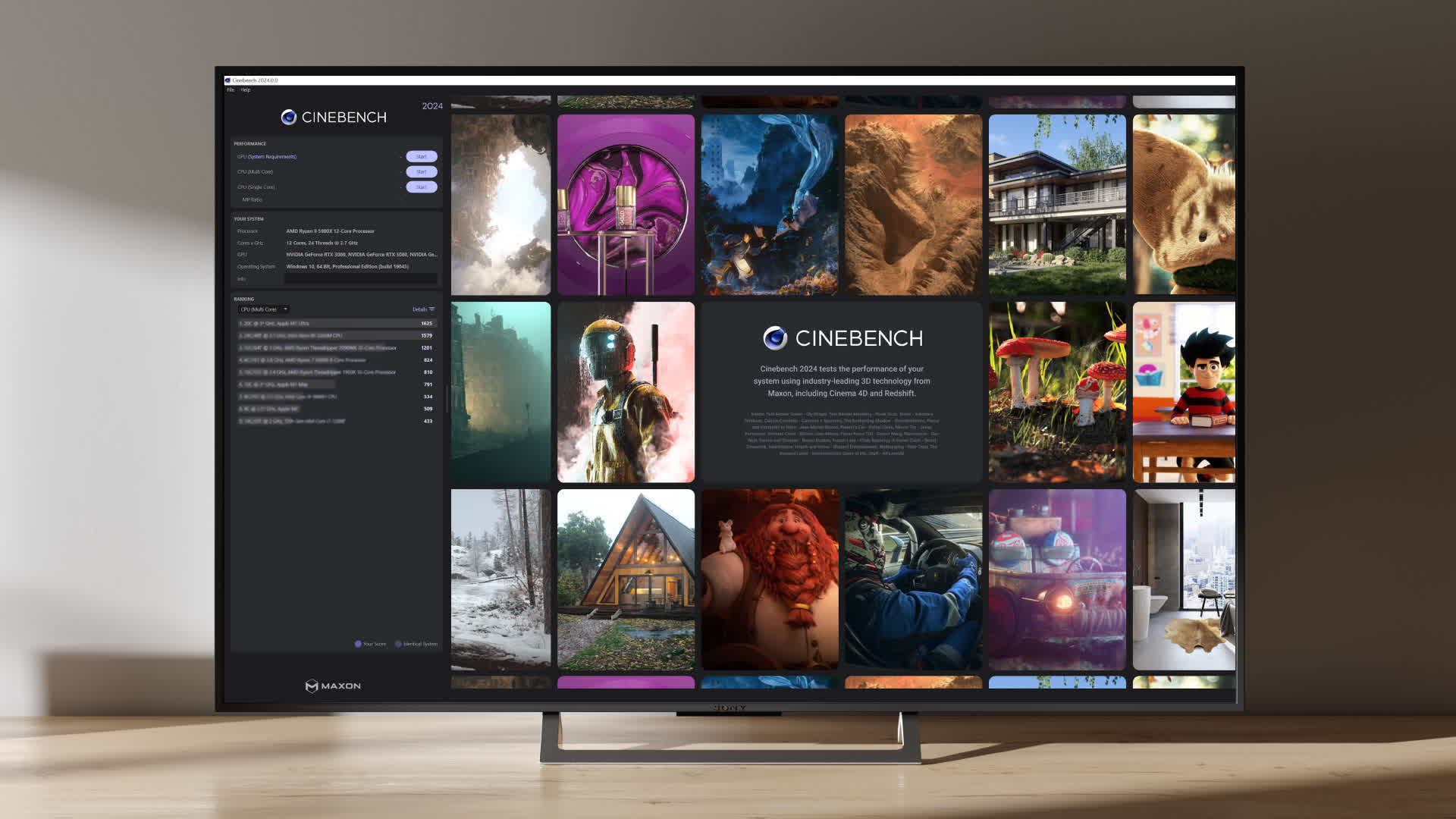Cinebench 2025 is great for analyzing how well a CPU manages threads and memory. Cinebench can be configured to render scenes using a set amount of threads, starting with just 1 (essentially just one core of the CPU) all the way up to 256.
For over a decade, Cinebench has been a popular tool to evaluate hardware performance and we use it extensively to test the latest CPUs on TechSpot reviews.
Cinebench 2024 (R24) is designed to accommodate a broad range of hardware configurations. It seamlessly supports x86/64 architecture (Intel/AMD) on Windows and macOS, it also extends its reach to Apple Silicon on macOS and Arm64 CPUs on Windows, ensuring compatibility with the latest advancements in hardware technology.
Additionally, Cinebench 2024 streamlines the benchmarking process by utilizing a consistent scene file for both CPU and GPU testing. Best of all: It's free!
What's new in Cinebench 2024 compared to R23?
Cinebench 2024 introduces several significant updates:
- Redshift Rendering Engine: Replaces the previous Cinema 4D engine, offering more modern and GPU-accelerated rendering capabilities.
- GPU Benchmarking: For the first time, Cinebench includes GPU performance testing, allowing users to assess both CPU and GPU rendering capabilities.
- Unified Scene File: Utilizes a single scene file for both CPU and GPU tests, ensuring consistent and comparable results across different hardware configurations.
How long is a Cinebench test?
In Cinebench 2024, the default CPU and GPU tests typically run for about 2 to 5 minutes each, depending on how powerful your hardware is.
Can the benchmark damage my CPU?
No, Cinebench only measures your CPU performance. It produces a score to compare PC systems. If your temps and voltages are safe, it will not hurt your computer.
Can I use Cinebench to benchmark my CPU and GPU?
Starting with the Cinebench 2024 version, you can test both CPU and GPU effectively.
Are Cinebench 2024 results comparable to scores from previous versions?
Cinebench 2024 has undergone a back-end overhaul, so Cinebench 2024 results are not comparable to the results from previous versions.
Who is Cinebench intended for?
Anyone who needs to evaluate hardware performance can use Cinebench to run tests. Individuals can evaluate their system, IT administrators can use Cinebench to help make purchase decisions, journalists can use the results in reviewing hardware, and manufacturers can utilize the feedback to optimize their latest products. Cinebench offers a real-world benchmark that incorporates a user's common tasks while using Cinema 4D and Redshift to measure a system's performance.
What are the minimum requirements for Cinebench 2024?
Cinebench 2024 requires Windows 10 or newer (64-bit) or macOS 11.7.7 or newer, with a 64-bit Intel or AMD CPU that supports AVX2, or ARM64 hardware for Windows 11 Snapdragon platforms. The minimum RAM requirement is 16 GB (though macOS can run the CPU test on 8 GB with performance trade-offs). For GPU benchmarking, a graphics card with at least 8 GB of VRAM is needed, supporting CUDA Compute Capability 5.0 or higher for NVIDIA GPUs or HIP-RT for AMD GPUs; Apple Silicon requires at least 16 GB unified memory for GPU testing. Systems lacking sufficient RAM or VRAM will display a warning and skip the benchmark.
Cinebench 2024 will not execute on unsupported processors. On systems lacking sufficient RAM to load the test scene, a warning will be displayed, and the CPU and/or GPU benchmark will not be executed.
Features
Main Processor Performance (CPU)
The test scenario uses all of your system's processing power to render a photorealistic 3D scene (from the viral "No Keyframes" animation by AixSponza). This scene makes use of various algorithms to stress all available processor cores.
In fact, Cinebench can measure systems with up to 256 processor threads. This test scene contains approximately 2,000 objects which in turn contain more than 300,000 polygons in total, and uses sharp and blurred reflections, area lights, shadows, procedural shaders, antialiasing, and much more. The result is displayed in points (pts). The higher the number, the faster your processor.
Graphics Card Performance (OpenGL)
This procedure uses a complex 3D scene depicting a car chase (created by renderbaron) which measures the performance of your graphics card in OpenGL mode. The performance depends on various factors, such as the GPU processor on your hardware, on the drivers used. The graphics card has to display a huge amount of geometry (nearly 1 million polygons) and textures, as well as a variety of effects, such as environments, bump maps, transparency, lighting and more to evaluate the performance across different disciplines and give a good average overview of the capabilities of your graphics hardware. The result is measured in frames per second (fps). The higher the number, the faster your graphics card is.
Who Should Use Maxon Cinebench?
Anyone who needs to evaluate hardware performance should add Maxon Cinebench to the test tool arsenal.System administrators can use Cinebench to help make purchase decisions, journalists can use the results in reviewing hardware, hardware manufacturers may utilize the feedback in optimizing their latest products. Any computer owner can evaluate his or her individual system. Unlike abstract benchmarks, which only test specific functions of CPUs or GPUs, Cinebench offers a real-world benchmark that incorporates a user's common tasks within CINEMA 4D to measure a system's performance. For those who have to do a serious amount of testing Cinebench also provides a command line option, allowing users to run automated test procedures.
What's New
Cinebench 2024.1.0 adds support for GPU accelerated Metal RT hardware ray tracing on M3-powered Macs (no changes for previously supported hardware)
Maxon, developers of professional software solutions for editors, filmmakers, motion designers, visual effects artists and creators of all types, is thrilled to announce the highly anticipated release of Cinebench 2024. This latest iteration of the industry-standard benchmarking software, which has been a cornerstone in computer performance evaluation for two decades, sets a new standard for performance evaluation, embracing cutting-edge technology to provide artists, designers, and creators with a more accurate and relevant representation of their hardware capabilities.
Redshift Rendering Engine Integration
Cinebench 2024 ushers in a new era by embracing the power of Redshift, Cinema 4D's default rendering engine. Unlike its predecessors, which utilized Cinema 4D's standard renderer, Cinebench 2024 utilizes the same render algorithms across both CPU and GPU implementations. This leap to the Redshift engine ensures that performance testing aligns seamlessly with the demands of modern creative workflows, delivering accurate and consistent results.
Dual Performance Evaluation: CPU and GPU
Cinebench 2024 reinstates GPU benchmarking, a feature absent from Cinebench for the past decade. The latest version not only evaluates CPU performance; it also provides insights into the GPU's capabilities, reflecting the evolving technological landscape of creative software and workflows.
Wider Platform Compatibility
Cinebench 2024 is designed to accommodate a broader range of hardware configurations. It seamlessly supports x86/64 architecture (Intel/AMD) on Windows and macOS, as well as Arm64 architecture to extend its reach to Apple silicon on macOS and Snapdragon® compute silicon on Windows, ensuring compatibility with the latest advancements in hardware technology. Redshift GPU performance can be evaluated on systems with compatible Nvidia, AMD and Apple graphics processors.
Unified Benchmarking Scene
Cinebench 2024 streamlines the benchmarking process by utilizing a consistent scene file for both CPU and GPU testing. This innovation enables users to discern the advantages of leveraging Redshift GPU, providing a real-world glimpse into the benefits of harnessing cutting-edge graphics hardware for rendering tasks.
Revamped User Interface
Cinebench 2024 introduces a revamped user interface that enhances the user experience and showcases the incredible artistic endeavors achieved with the Redshift render engine in Cinema 4D. This dynamic interface serves as a testament to the potential of the Redshift engine while offering users a more intuitive and visually engaging experience.
Under-the-Hood Enhancements
Beyond the surface, Cinebench 2024 brings forth a host of performance-enhancing features. With a threefold increase in memory footprint compared to Cinebench R23, the software caters to the memory-intensive demands of modern projects. Moreover, a six-fold rise in computational effort and utilization of newer instruction sets ensures a benchmark that resonates with the complexity and sophistication of contemporary creative projects.
Unparalleled Performance Evaluation
It's crucial to note that Cinebench 2024 scores cannot be directly compared to those of its predecessor, Cinebench R23. With the incorporation of Redshift, a different rendering engine, larger memory footprint, and more complex scenes, Cinebench 2024 offers a distinctly enhanced and accurate evaluation of modern hardware capabilities.
Cinebench R23 and Cinebench R20 is still widely used for testing, you can choose and download that by choosing the appropriate version in the download options menu. We also host Cinebench R15 for Windows and Mac for the same reasons.



